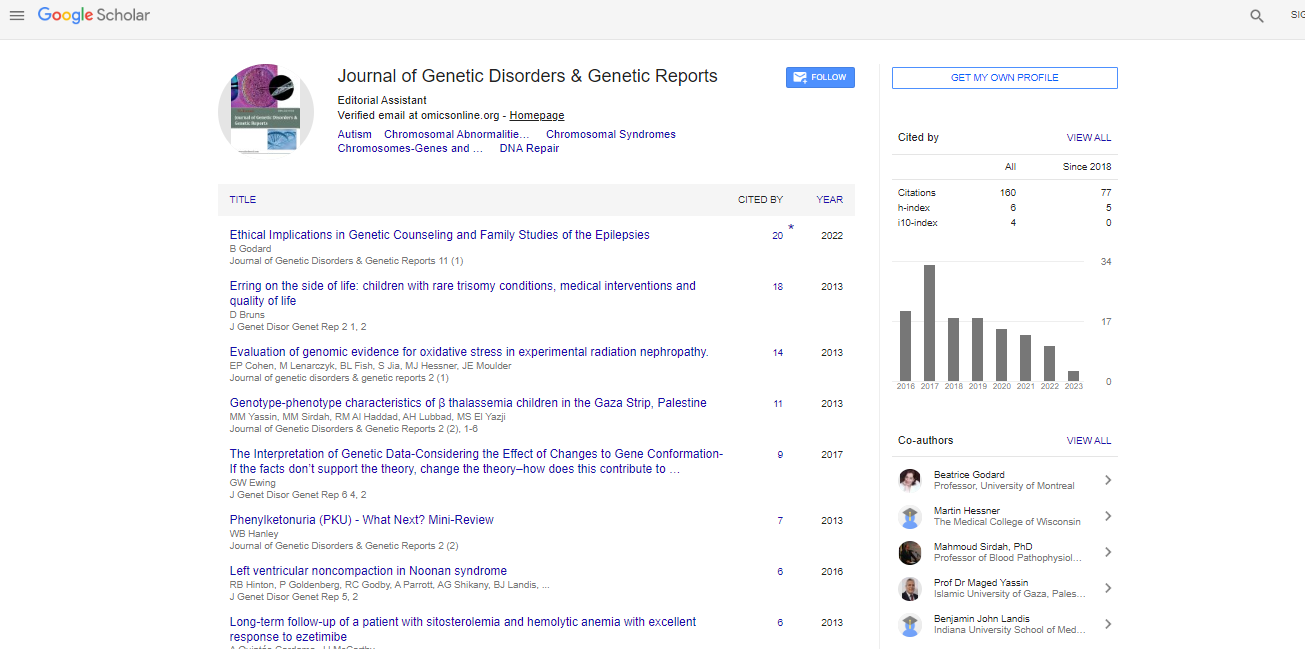Editorial, J Genet Disor Genet Rep Vol: 1 Issue: 1
Genetic Determinants of Salt- Sensitive Hypertension
| Marlene Shehata*, Fady Youssef and Alan Pater | |
| Marlene Shehata Pharmaceuticals, Southwestern Ontario, Canada | |
| Corresponding author : Marlene Shehata PhD Clinical Pharmacist Consultant/Cardiovascular Geneticist, Marlene Shehata Pharmaceuticals, Southwestern Ontario, Canada. Tel: 519-702-5476; Fax: 347-710-5334 E-mail: marlenefouad@yahoo.com |
|
| Received: June 19, 2012 Accepted: June 20, 2012 Published: June 22, 2012 doi: 10.4172/2327-5790.1000e101 | |
| Citation: Marlene Shehata1, et al. (2013) Genetic Determinants of Salt- Sensitive Hypertension. doi:10.4172/2324-9331.1000e101 |
Abstract
Genetic Determinants of Salt - Sensitive Hypertension
Despite the marked advances in research on genetic determinants of salt-sensitive hypertension in human and animal models of saltsensitivity, the mechanisms underlying salt-sensitivity that is induced by high levels of salt in the diet remain unclear. While excessive dietary sodium chloride (NaCl or salt) intake is a predominant cause of hypertension, the individual blood pressure response to high salt intake is heterogeneous. The existence of interindividual variability in the genetic make-up of individuals might explain the different blood pressure responses to excessive dietary salt intake.
| Despite the marked advances in research on genetic determinants of salt-sensitive hypertension in human and animal models of saltsensitivity, the mechanisms underlying salt-sensitivity that is induced by high levels of salt in the diet remain unclear. | |
| While excessive dietary sodium chloride (NaCl or salt) intake is a predominant cause of hypertension, the individual blood pressure response to high salt intake is heterogeneous. The existence of interindividual variability in the genetic make-up of individuals might explain the different blood pressure responses to excessive dietary salt intake. | |
| Animal models of salt-sensitive hypertension such as Dahl rats are convenient in studying the genetic and molecular factors contributing to salt-sensitivity [1]. Dahl rats are inbred rats that respond differently to high salt-intake. While Dahl S (salt-sensitive) rats develop high blood pressure when fed high salt diet, a sister strain Dahl R (salt-resistant) rats remain resistant to elevation in blood pressure when fed high salt diet. Dahl S and R rats have been used frequently to study the genetic causes of human salt-sensitive hypertension. | |
| We have studied the genetic differences in the epithelial sodium channel (ENaC) in Dahl S vs R rats. We examined the three subunits (alpha, beta and gamma) that make up the ENaC in Dahl rats. Our genetic analyses studies using two different methods of genetic screening (sequencing and denaturing high performance liquid chromatography) failed to find any genetic differences between the two Dahl rat strains in the 5` and 3`, whole coding regions and carboxy-terminal regions [2]. However, genetic differences can still reside in the non-coding regions that are yet to be screened. | |
| At the mRNA level, the alpha ENaC subunit levels were higher in Dahl R versus S rats. Interestingly, the abundance of the alpha ENaC salt-sensitive splice variant “b” was significantly higher 4-weeks post high salt diet compared to normal salt diet in Dahl R rats [3]. These unique differences in mRNA levels of the ENaC alpha subunit transcripts might be attributed to many factors including the presence of genetic variations in the non-coding regions of the three ENaC subunits in Dahl S versus R rats, genetic and/or molecular differences in ENaC regulators in Dahl S versus R rats, and other defects in candidate genes along the salt-sensitive pathway that contribute to high salt-induced hypertension in Dahl S rats. | |
| While it is essential to pursue the differences in ENaC three subunits in Dahl S versus R rats (at the mRNA, protein and activity levels), it is also essential to apply computational methods including text- and data-mining to prioritize candidate genes for salt-sensitive hypertension [4]. The impact of single nucleotide polymorphisms identified in candidate genes can be examined individually and in combination using univariate and multivariate analysis [5]. The above approaches would expedite the process of selecting and prioritizing candidate genes in salt-sensitive hypertension in Dahl rats. | |
References |
|
|
 Spanish
Spanish  Chinese
Chinese  Russian
Russian  German
German  French
French  Japanese
Japanese  Portuguese
Portuguese  Hindi
Hindi 



